Back to the Future, Dr. Who, and The Time Machine all tantalize our curiosity about the possibilities of time travel. The ability to observe future and especially past events for the historically inclined, entices one to think about all the different moments in history someone would want to visit and see first hand. Many would choose to observe events like the signing of the Declaration of Independence or witness the Confederation of Canada, but for the hockey fan it’s different. “There’s a time machine!? Get me to Lake Placid, New York on February 22nd, 1980, then bring me to the old Boston Garden on Mother’s Day 1970!” Every hockey fan would capitalize on the chance to see the great moments and players of the past they were too young to see themselves, except through old grainy video footage or sports history books.
But… what about taking it a step further back in this time machine? Wouldn’t it be fascinating to witness the historical events that laid the foundation to hockey as we know it? One must go beyond the Original Six Era, the founding of the National Hockey League (NHL), or even beyond what many historians consider to be the first “modern” ice hockey game.
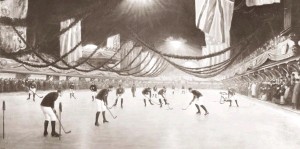
That particular hockey game took place on March 3rd, 1875 within the confines of the Victoria Ice Rink in Montreal between members of the rink’s skating club members. The International Ice Hockey Federation (IIHF) observes this event to be the birth of organized ice hockey and for good reason. The game is believed to be the first played indoors, with a puck (made out of wood), and have extensive pregame and post game press coverage. What this “first” game in Montreal does not tell us is where hockey’s true origins lie in human history. By 1874, there were already many key advances that had come together in hockey’s development that helped shape the game in to what it is today, from the invention of ice skating, to the idea of propelling a puck or ball with a stick, to the strange concept of playing a game on ice. Many even continue to argue that modern hockey began prior to the 1875 game in Montreal.
Although these separate historical events were not hockey on their own, they each played a key role as they converged on creating ice hockey in Canada sometime in the 19th century.
Ancient Stick & Ball Games
Around 10,000 BC human civilization advanced itself beyond the age of hunting and gathering. Now that people were not always traveling and had a regular source of nourishment from farming, they began to have free time and excess energy to burn. Over time people began to take advantage of this more sedentary lifestyle by playing various games, some that included using a stick, usually made out of roughly carved tree branches to move a ball, sometimes made of tightly knitted fabric or just a fairly round rock, towards a predesignated area in a field. The goal net as we think of it today did not exist. The goal was to carry or pass the ball to a designated area on the field, similar to a modern football end zone, to score a point. Playing areas could range from anywhere from 200 feet to many acres of land.
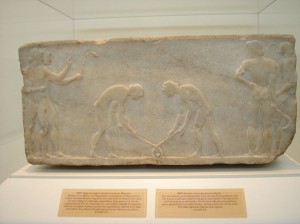
One of the earliest images of one of these stick & ball game was found on the walls inside the Tomb of Kheti in Beni Hasan, Egypt, which was constructed sometime during Ancient Egypt’s middle kingdom period (2000 BC to 1700 BC). The wall drawing shows two individuals surrounding a ball in what appears to be something similar to a hockey face off. You can almost picture them clashing their sticks three times before swiping for the dormant ball laid between them as if it was a street hockey game.
The fact that this image was drawn in a tomb demonstrates the importance that some of these early stick and ball games took on in these ancient civilizations. These games occasionally took on religious and political importance, sometimes replacing war. Instead of a chaotic battles, opposing sides would take part in chaotic games. The stakes of losing occasionally meant the life of the defeated players. With that much on the line, games became very dangerous. Having possession of the ball for too long could mean a broken arm, leg, or strike to the head by an opponent’s stick. Unfortunately, no referee or department of player safety headed by Brendan Shanahan existed to protect these players.
These rough field hockey like games were also played in Ancient Mesopotamia, Athens, Rome, and South America with varying rules and approaches.
The First Ice Skate
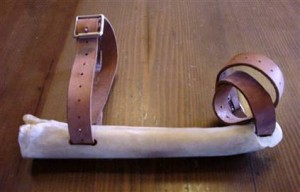
The earliest known ice skate was discovered at the bottom of a lake in Finland and appears to have been made around 3000 BC.
The skate blade was made of cut cow or horse bones. The bone is pierced at both ends so a strap can be placed through it making it possible to tie it around the users foot. Since the skate blade did not have a boot connected to it, the person wearing the skates would have to have a regular shoe on already.
As of now, it appears these skates were only used for efficient travel during the long and difficult winters of ancient Scandanavia. There is no evidence of an ice based game being played in that region during that time period.
Ice Colf
The game of “Kolven” or “Colf” is a European sport, vaguely resembling the modern sport of golf. Colf began to be played around 1200 AD during the high middle ages as a gentlemen’s game. It was normally played in fields and sometimes indoors with short poles at each end of the playing area. Players struck the ball from end to end 3 times, hitting the post at one side of the playing area before striking the ball back to the other end.
While this game is more closely tied to the eventual development of golf, the game was forced out to the ice due to environmental circumstances.
The Little Ice Age (1550 AD to 1850 AD) is a period of temperature cooling, that primarily effected the Northern Hemisphere and especially Europe. People were forced to adapt to longer and harsher winters in many ways, including their recreational activities. By that time, Colf had a long tradition in many regions of Europe and people were not going to just stop playing due to the cold.
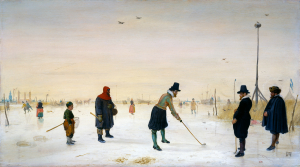
The game was easily incorporated in to the growing popularity of winter amusements, which included ice skating. The increased velocity the ball traveled over the ice added a new dynamism not found in the other forms of the game. Players did not wear skates to play the game, as the proper posture to shoot the ball was best accomplished when on flat feet. However, there are numerous paintings from this time period that depict individuals wearing skates, carrying a curved stick, attempting to strike a ball.
The Word “Hockey”
Currently the earliest documentation found using the word “hockey” was in a proclamation written by King Edward III of England in 1363 that was intended to make sports illegal under the classification of inappropriate public behavior. These sorts of laws were enforced intermittently throughout the middle ages and in to the early 19th century as sport and many other recreations, were thought too create too much unneeded excitement among the commoners by those in power. The games continued to be played behind the backs of authority and were passed on from generation to generation.
The word hockey definitely entered the English lexicon to describe a specific version of a stick and ball game in England by 1799. The following quote from that year, written by a young boy named William Pierre Le Cocq writing to his parents from a boarding school in Chesham, England, demonstrates this:
“I must now describe to you the game of Hockey; we have each a stick turning up at the end. We get a bung. There are two sides one of them knocks one way and the other side the other way. If any one of the sides makes the bung reach that end of the churchyard it is victorious.”
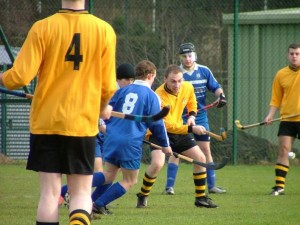
The word hockey sometimes took on alternate spellings such as “hockie” and “hawkey.” “Hawkey sticks” sold in England during the early 19th century were much smaller than the modern hockey stick. They were only about waist high and had a very short blade. Some complained that these sticks often ended up in the hands of young rabble-rousers who would shoot rocks and trash around the side walks when walking the streets of cities and towns.
By this point, society began to view sports and exercise as beneficial to personal health and to helping one become a well rounded individual. Field hockey and other similar stick and ball games such as Scottish Shinty and Irish hurling grew in popularity. Coincidentally, a vast majority of the immigrants moving to Canada were of English, Scottish, and Irish descent. These newcomers brought their sporting traditions with them to the icy and snowy confines of Canada.
Ice Hockey in Canada
The earliest documentation of the game of hockey being played on ice was written by explorer John Franklin in his description of his travels throughout the Northwest Territories of Canada on October 20th, 1825. He and his companions played this game on a small lake in the town of Deline, located near Great Bear Lake. It is unclear whether they wore boots or skates during the game. His journal entry describes skating on the lake, but later explains hockey as an entirely separate activity.
The following 50 years (1825-1875) creates the greatest amount of discussion, as numerous Canadian communities passionately claim to be the founders of modern ice hockey. I could write a book on this specific time in hockey’s history, but will keep this short.
Some argue that Kingston, Ontario was the birthplace of ice hockey due to a quote written in a British Army Officer’s journal in 1843 while stationed there stating, “Began to skate this year, improved quickly and had great fun at hockey on the ice.” Although the terms skating and hockey appeared in this quote, some historians contend that it’s inconclusive if these soldiers wore skates while playing hockey or if it was a separate activity.
Windsor, Nova Scotia has received significant attention by the Canadian media and the town even has a sign naming it “The Birthplace of Hockey.” This claim is based off of a quote in an 1844 novel written by acclaimed author Thomas Chandler Haliburton who attended King’s College in Windsor. The quote mentions a game of ice hurley being played on a local Windsor pond named “Long Pond” around the year 1800.
“…and you boys let out racin’, yelpin’, hollerin, and whoopin’ like mad with pleasure, and the play-ground, and the games at bass in the fields, or hurly on the long pond on the ice…”
Skeptical historians focus on the fact that this quote makes no reference of skating or the term hockey, and that this quote comes from a fictional novel. Proponents of Windsor’s claim acknowledge that while Haliburton’s book is indeed a work of fiction, much of it was based off of his own experiences attending King’s College and that the version of ice hurley played on the ice on long pond was the very predecessor of what became modern ice hockey.
Town of Windsor Website: http://www.town.windsor.ns.ca/birthplace-of-hockey.html
The Halifax/ Dartmouth region in Nova Scotia claims to be the birthplace of hockey as well, except with a lot less attention. There are various reports by British garrison that describe an early stick & ball game played on ice by the local Mi’kmaq natives of that region. The Mi’kmaq later became reputable for their superior one piece wooden hockey stick design and were the primary supplier of sticks to Canada and New England for many years. It should be noted that the Mi’kmaq were also native of Windsor as well.
Dartmouth’s Starr Manufacturing Company patented the “Forbes Acme Skate” in 1866, which became a significant supplier of hockey skates soon after for nearly a century. Some suggest that this patent is an indicator that the Starr Company attempted to capitalize on the growing popularity of ice hockey in Nova Scotia, but again historians point out that these early patents make no mention of “hockey skates” just regular “ice skates” suggesting this company inadvertently fell in to the hockey skate market a few years later when the game became popular out of Montreal.
Halifax and Dartmouth Supporting Website: http://www.hockeyshome.ns.ca/index.htm
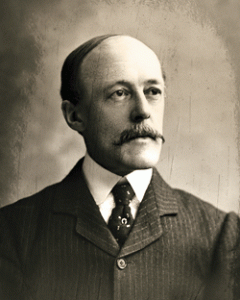
The most significant claim for Halifax is that James Creighton, the organizer, promoter, and one of the team captains in the 1875 indoor game in Montreal’s Victoria ice rink, grew up there. In Halifax he played the many variations of 19th century ice hockey such as ice hurly, ice shinty, shinny, and ricket. He was already a 22 year old man when he moved to Montreal in 1872 and was the perfect fountain of ideas for helping develop the first formalized rules of hockey. It’s still not known for sure if the rules he wrote for the first indoor game were already used in the outdoor games he played as a child. Regardless, these rules were finally written down in Montreal in 1875, then later expanded upon in 1877 to transform ice hockey in to one specific sport.
The debate rages on in Canada as to what town or city is the true birthplace of modern ice hockey and although one place or time cannot be definitively chosen yet, I would have a hell of a good time using that time machine to watch and join in on all of those early versions of hockey.